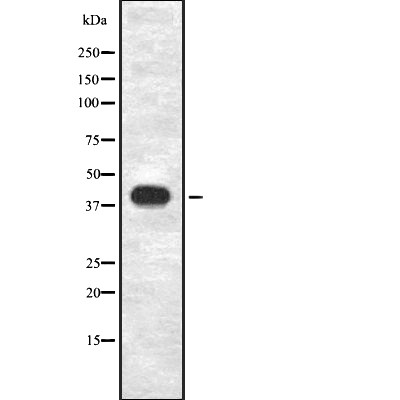AGTR2 Antibody - #DF7928
| Product: | AGTR2 Antibody |
| Catalog: | DF7928 |
| Description: | Rabbit polyclonal antibody to AGTR2 |
| Application: | WB IHC |
| Reactivity: | Human, Mouse, Rat |
| Prediction: | Pig, Bovine, Horse, Rabbit, Dog |
| Mol.Wt.: | 41 kDa; 41kD(Calculated). |
| Uniprot: | P50052 |
| RRID: | AB_2841340 |
Related Downloads
Protocols
Product Info
*The optimal dilutions should be determined by the end user.
*Tips:
WB: For western blot detection of denatured protein samples. IHC: For immunohistochemical detection of paraffin sections (IHC-p) or frozen sections (IHC-f) of tissue samples. IF/ICC: For immunofluorescence detection of cell samples. ELISA(peptide): For ELISA detection of antigenic peptide.
Cite Format: Affinity Biosciences Cat# DF7928, RRID:AB_2841340.
Fold/Unfold
AGTR 2; Agtr2; AGTR2_HUMAN; angiotensin II receptor type 2; Angiotensin II type-2 receptor; Angiotensin receptor 2; AT 2; AT2; ATGR 2; ATGR2; MRX 88; MRX88; Type 2 angiotensin II receptor; Type-2 angiotensin II receptor;
Immunogens
A synthesized peptide derived from human AGTR2
In adult, highly expressed in myometrium with lower levels in adrenal gland and fallopian tube. Expressed in the cerebellum. Very highly expressed in fetal kidney and intestine.
- P50052 AGTR2_HUMAN:
- Protein BLAST With
- NCBI/
- ExPASy/
- Uniprot
MKGNSTLATTSKNITSGLHFGLVNISGNNESTLNCSQKPSDKHLDAIPILYYIIFVIGFLVNIVVVTLFCCQKGPKKVSSIYIFNLAVADLLLLATLPLWATYYSYRYDWLFGPVMCKVFGSFLTLNMFASIFFITCMSVDRYQSVIYPFLSQRRNPWQASYIVPLVWCMACLSSLPTFYFRDVRTIEYLGVNACIMAFPPEKYAQWSAGIALMKNILGFIIPLIFIATCYFGIRKHLLKTNSYGKNRITRDQVLKMAAAVVLAFIICWLPFHVLTFLDALAWMGVINSCEVIAVIDLALPFAILLGFTNSCVNPFLYCFVGNRFQQKLRSVFRVPITWLQGKRESMSCRKSSSLREMETFVS
Predictions
Score>80(red) has high confidence and is suggested to be used for WB detection. *The prediction model is mainly based on the alignment of immunogen sequences, the results are for reference only, not as the basis of quality assurance.
High(score>80) Medium(80>score>50) Low(score<50) No confidence
Research Backgrounds
Receptor for angiotensin II. Cooperates with MTUS1 to inhibit ERK2 activation and cell proliferation.
Cell membrane>Multi-pass membrane protein.
In adult, highly expressed in myometrium with lower levels in adrenal gland and fallopian tube. Expressed in the cerebellum. Very highly expressed in fetal kidney and intestine.
Belongs to the G-protein coupled receptor 1 family.
Research Fields
· Environmental Information Processing > Signaling molecules and interaction > Neuroactive ligand-receptor interaction.
· Organismal Systems > Circulatory system > Adrenergic signaling in cardiomyocytes. (View pathway)
· Organismal Systems > Endocrine system > Renin-angiotensin system. (View pathway)
Restrictive clause
Affinity Biosciences tests all products strictly. Citations are provided as a resource for additional applications that have not been validated by Affinity Biosciences. Please choose the appropriate format for each application and consult Materials and Methods sections for additional details about the use of any product in these publications.
For Research Use Only.
Not for use in diagnostic or therapeutic procedures. Not for resale. Not for distribution without written consent. Affinity Biosciences will not be held responsible for patent infringement or other violations that may occur with the use of our products. Affinity Biosciences, Affinity Biosciences Logo and all other trademarks are the property of Affinity Biosciences LTD.



